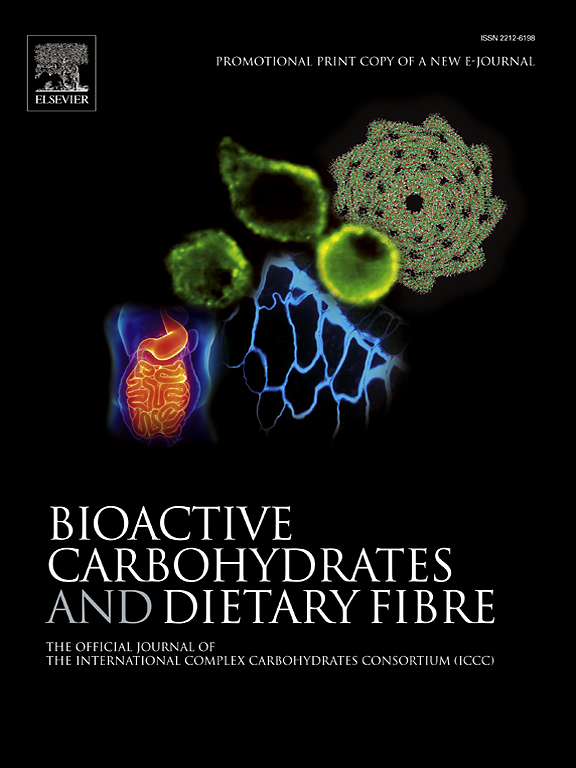Gum Arabic regulates glucose metabolic enzymes through modification of hepatic phosphoenolpyruvate carboxykinase expression in diabetic rats
IF 3.6
引用次数: 0
Abstract
Diabetes mellitus (DM) is a chronic metabolic disease that becomes one of the most serious problems of modern times, due to its long-lasting health complications. Gluconeogenesis is a responsible for continued production of glucose by using glucose synthesis enzymes. However, the effect of Gum Arabic (GA) on phosphoenolpyruvate carboxykinase (PEPCK) enzymes has not been reported. This study aims to investigate the effect of GA on PEPCK enzymes in diabetes rats. A total of thirty male Sprague-Dawley rats were divided into 3 groups (n = 10 of each): control group; diabetic group (150 mg/kg Alloxan); and diabetic group which was given 10 % GA in drinking water for 8 weeks. The effect of GA on lipid profile, serum glucose, and liver function enzymes levels were investigated. Oxidative stress gene activities, hepatic glucose regulating-enzymes, G6p1 and PEPK mRNA expression were measured. The result revealed GA administration significantly decreased plasma total cholesterol, and LDL concentrations compared to the diabetic group. GA-treatment significantly decreased concentrations of serum glucose, leptin, and TNF-α, and increased serum insulin compared to the diabetic group. Furthermore, treatment with GA significantly ubregulated SOD, CAT and GSH-Px concentration compared to the diabetic group. Consequently, GA-treatment significantly downregulated the activity of PEPCK, and Glucose-6-phosphatase enzymes and ubregulated hepatic hexokinase and pyruvate kinase activities compared to the diabetic groups. Likewise, GA-treatment significantly down-regulated the PEPK and G6p1 protein expression in liver compared to the diabetic group. Our findings suggest that the administration of GA prevented diabetic behavior via modification of PEPCK expression in diabetes rats.
阿拉伯胶通过改变糖尿病大鼠肝脏磷酸烯醇丙酮酸羧激酶的表达来调节葡萄糖代谢酶
糖尿病(DM)是一种慢性代谢性疾病,由于其长期的健康并发症而成为现代最严重的问题之一。糖异生是利用葡萄糖合成酶持续生产葡萄糖的过程。然而,阿拉伯树胶(GA)对磷酸烯醇丙酮酸羧激酶(PEPCK)酶的影响尚未见报道。本研究旨在探讨GA对糖尿病大鼠PEPCK酶的影响。选取雄性sd大鼠30只,随机分为3组,每组10只:对照组;糖尿病组(150mg /kg四氧嘧啶);糖尿病组在饮水中添加10% GA,连续8周。研究了GA对血脂、血清葡萄糖和肝功能酶水平的影响。测定氧化应激基因活性、肝糖调节酶、G6p1和PEPK mRNA表达。结果显示,与糖尿病组相比,GA给药显著降低了血浆总胆固醇和LDL浓度。与糖尿病组相比,ga治疗显著降低了血清葡萄糖、瘦素和TNF-α的浓度,并增加了血清胰岛素。此外,与糖尿病组相比,GA治疗显著调节SOD、CAT和GSH-Px浓度。因此,与糖尿病组相比,ga处理显著下调了PEPCK和葡萄糖-6-磷酸酶的活性,并调节了肝脏己糖激酶和丙酮酸激酶的活性。同样,与糖尿病组相比,ga处理显著下调肝脏中PEPK和G6p1蛋白的表达。我们的研究结果表明,GA通过改变糖尿病大鼠的PEPCK表达来预防糖尿病行为。
本文章由计算机程序翻译,如有差异,请以英文原文为准。
求助全文
约1分钟内获得全文
求助全文
来源期刊

Bioactive Carbohydrates and Dietary Fibre
Agricultural and Biological Sciences-Food Science
CiteScore
6.00
自引率
0.00%
发文量
38
期刊介绍:
 求助内容:
求助内容: 应助结果提醒方式:
应助结果提醒方式:


